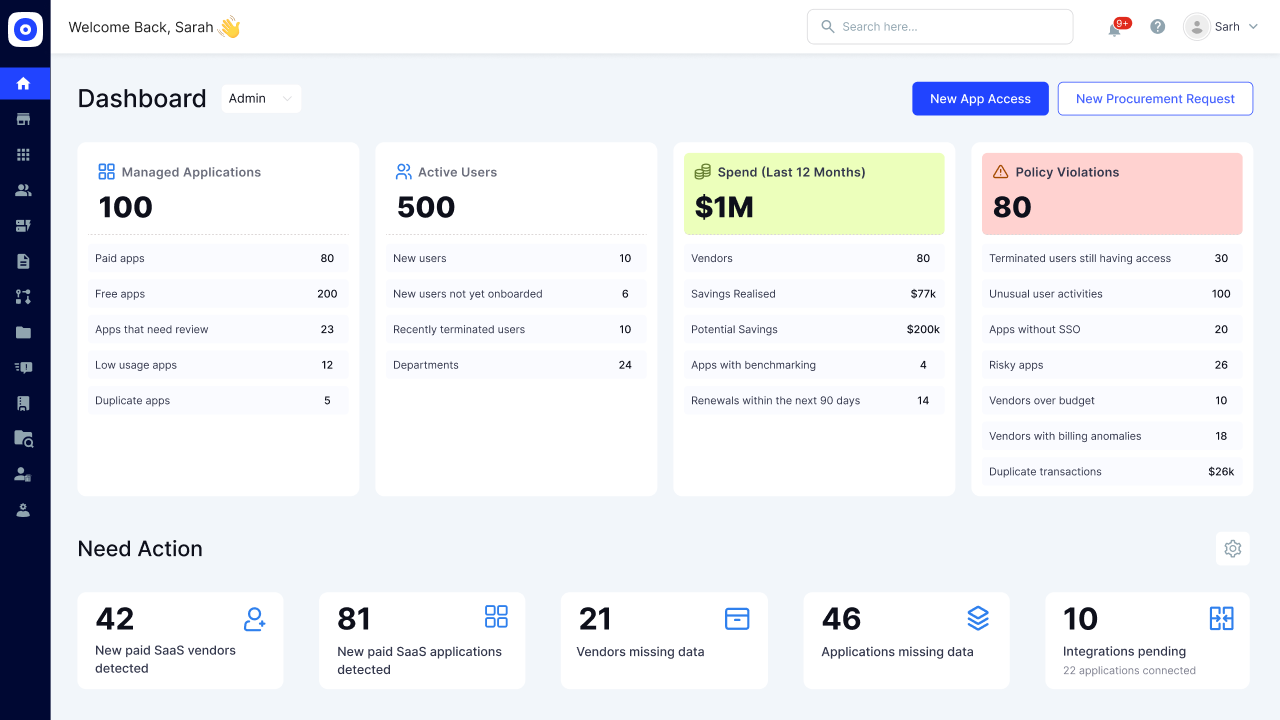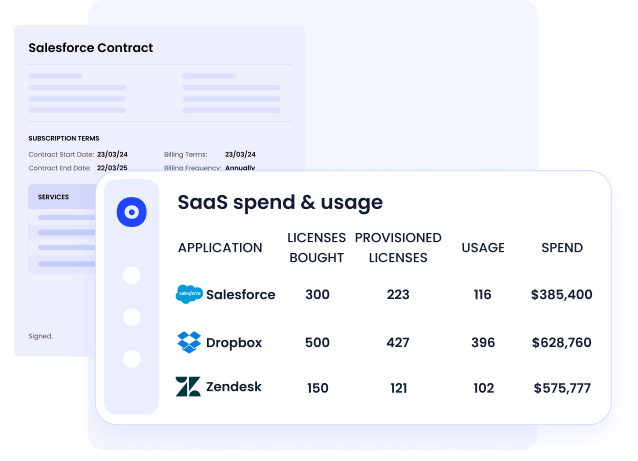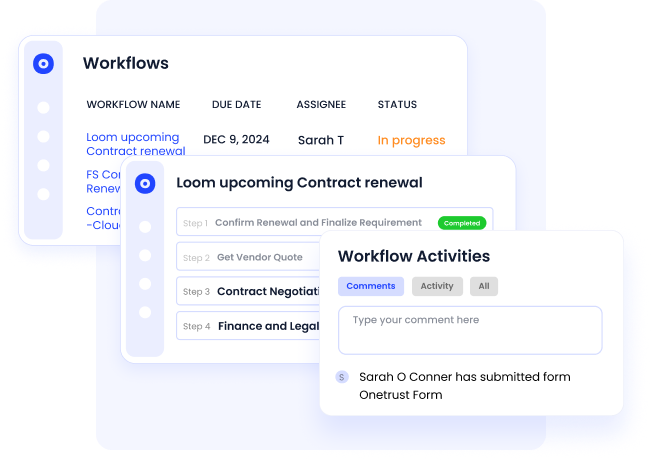HIPAA Compliance Checklist for 2025

Businesses are constantly juggling between making long-term tech investments and managing day-to-day operational costs. This financial balancing act brings us to two core budgeting strategies: Capital Expenditure (CapEx) and Operational Expenditure (OpEx).
Whether you're purchasing new servers or subscribing to a SaaS tool, how your organization classifies these expenses can significantly impact your budget planning, tax strategy, and financial agility. Especially with the rapid shift to cloud-based solutions, understanding the difference between CapEx and OpEx has never been more critical for CIOs, CFOs, and IT leaders.
In this blog, we'll break down CapEx vs. OpEx, their key differences, and how they shape IT budgeting strategies. We’ll also show you how platforms like CloudEagle can help manage and optimize these expenses in the age of SaaS.
TL;DR: CapEx vs. OpEx in a Nutshell
- CapEx (Capital Expenditure): Long-term investments like hardware, infrastructure, or software development; appears on the balance sheet and depreciates over time.
- OpEx (Operational Expenditure): Ongoing operational costs like SaaS subscriptions, cloud hosting, and support services; fully deductible in the same fiscal year.
- CapEx is about ownership and long-term ROI; OpEx is about flexibility and agility.
- The shift from CapEx to OpEx is accelerating due to cloud computing and subscription-based IT models.
- Tools like CloudEagle simplify tracking, budgeting, and optimizing both CapEx and OpEx, especially in complex SaaS environments.
What is Capital Expenditure (CapEx)?
Capital Expenditure (CapEx) refers to long-term investments a business makes in assets that will provide value over time. These expenses are typically associated with acquiring, upgrading, or maintaining physical or intangible assets that will be used for more than one fiscal year.
Examples include:
- Purchasing servers or networking hardware
- Building a new data center
- Investing in custom-built software or major ERP systems
- Buying office equipment or real estate
CapEx is recorded on the balance sheet and depreciated over the asset's useful life, impacting long-term budgeting and tax implications.
What is Operational Expenditure (OpEx)?
Operational Expenditure (OpEx) refers to the ongoing expenses a company incurs for day-to-day operations. These are shorter-term, recurring costs that are fully deductible in the year they're incurred.
Common OpEx items include:
- SaaS subscriptions
- IT support services
- Cloud computing services (like AWS, Azure)
- Salaries for IT staff
- Software licenses (paid annually or monthly)
- Utilities and internet services
These expenses show up on the income statement and directly affect the operating profit of the business.
Why CapEx vs. OpEx Matters for IT Budgeting
In the IT world, understanding CapEx vs. OpEx is critical for effective budgeting, planning, and strategy. As organizations move towards agile and cloud-based environments, IT teams must rethink their investment approach.
Here’s why this distinction matters:
- Financial Flexibility: OpEx allows for easier scaling and adjustment, which aligns better with rapid digital transformation.
- Budget Planning: CapEx requires larger up-front investment, whereas OpEx spreads costs over time.
- SaaS & Cloud Shift: The rise of SaaS tools and IaaS platforms makes many IT expenditures fall under OpEx rather than CapEx.
- Tax Implications: OpEx is fully deductible, reducing taxable income in the same year.
Understanding the shift from CapEx to OpEx in IT is now a strategic discussion in every finance and technology team.
What is the Difference Between CapEx vs OpEx?
a. Nature of Expenses - CapEx expenses are strategic, big-ticket items that will benefit the company over the long term. OpEx, in contrast, is tactical, covering the operational needs to keep the business running.
b. Time Horizon and Financial Impact - CapEx decisions often tie up budgets for years and require approval from top executives. OpEx, being more flexible, allows for faster procurement and payment cycles.
c. Purpose and Business Focus - CapEx is about ownership and long-term stability. OpEx is about agility, scalability, and low overhead.
d. ROI and Value Realization - While CapEx has delayed ROI due to depreciation, OpEx provides faster value realization and better alignment with modern subscription-based models.
e. Tax and Accounting Treatment - OpEx directly reduces net income and is easier to track for cash flow purposes. CapEx, however, offers tax shields through depreciation.
How to Calculate CapEx and OpEx
Understanding how to calculate both CapEx and OpEx is essential for CFOs and IT leaders.
Formula for CapEx Calculation (Including Depreciation)
A simple formula for calculating CapEx from financial statements:
CapEx = PP&E (Current Year) - PP&E (Previous Year) + Depreciation
Where PP&E is Property, Plant, and Equipment.
Example: If a company had PP&E of $500,000 in Year 1 and $650,000 in Year 2, and recorded $50,000 in depreciation:
CapEx = 650,000 - 500,000 + 50,000 = $200,000
This $200,000 indicates the company's new investments in long-term assets.
Typical Line Items Considered OpEx in IT Budgets
Operating expenses (OpEx) in IT budgeting are ongoing costs associated with the day-to-day operation and maintenance of technology infrastructure and services. Common OpEx line items include:
- Cloud Infrastructure Usage (IaaS): Monthly or usage-based charges for compute, storage, and networking services from providers like AWS, Azure, or Google Cloud.
- SaaS Subscriptions: Recurring fees for cloud-based software such as Zoom, Slack, Salesforce, and other productivity or collaboration tools.
- Annual Support and Maintenance Fees: Payments for software updates, patches, technical support, and service-level agreements (SLAs) from vendors.
- IT Consultants and External Managed Services: Outsourced expertise for implementation, support, or infrastructure management on a retainer or hourly basis.
- Backup-as-a-Service (BaaS): Monthly fees for secure off-site data backup and disaster recovery services.
- DevOps Tools on Monthly Billing Cycles: Subscriptions to CI/CD platforms, container orchestration, and monitoring tools like GitLab, Jenkins, or Datadog billed as OpEx.
Tools and Reports for Tracking CapEx vs. OpEx
To track and manage these expenses, finance teams use:
- ERP Systems: Centralized platforms that categorize and report financial transactions, enabling granular visibility into CapEx and OpEx allocations.
- SaaS Management Platforms: Provide real-time insights into SaaS and cloud usage, optimize subscriptions, and help classify expenses accurately across departments.
- Budgeting and Forecasting Tools: Support strategic planning and predictive modeling to estimate future OpEx and CapEx needs.
- Expense Reports Tied to IT Cost Centers: Used to analyze and justify spending patterns by associating each cost with the appropriate department or project.
Example Calculation Scenarios
Scenario 1 (CapEx): An enterprise buys a server for $100,000, depreciated over 5 years at $20,000/year.
CapEx = $100,000; Depreciation = $20,000/year
Scenario 2 (OpEx): The same enterprise opts for AWS EC2 with a monthly cost of $5,000.
OpEx = $60,000 annually, fully expensed each year
How CloudEagle Helps with SaaS Expense Management
As organizations shift IT spend from CapEx to OpEx, managing software costs across departments becomes increasingly complex. CloudEagle empowers IT, Finance, and Procurement teams to gain complete control over SaaS spending while reducing waste and improving ROI, all from a single platform.
Here’s how CloudEagle drives measurable savings and smarter decisions:
Real-Time SaaS Visibility

CloudEagle integrates with 500+ apps to give you a complete, real-time view of all SaaS tools, licenses, and vendors across your company. Track who’s using what, detect shadow IT, and uncover apps flying under the radar. Eliminate blind spots and make data-driven decisions with confidence. One centralized dashboard replaces dozens of spreadsheets and disconnected tools
Intelligent Cost Optimization

Identify unused or underutilized licenses and take automated action to harvest them.
AI helps you detect duplicate tools, downgrade overprovisioned users, and right-size subscriptions. Reallocate licenses instantly or de-provision them to reduce waste. Customers typically save 10–30% within the first few months.
AI-Powered Contract Intelligence & Renewals

Automatically extract metadata from contracts, renewal dates, license counts, opt-out clauses, using our AI engine. Get proactive alerts ahead of renewals so you never miss a deadline or auto-renew at poor terms. Benchmark pricing and usage data to negotiate better deals. Streamline procurement workflows and reduce time spent chasing approvals.
CapEx vs. OpEx Classification
Tag every SaaS expense as CapEx or OpEx to align with accounting practices. Gain better insight into operational vs. capital spend across business units. Improve financial forecasting and reporting accuracy. Ensure finance teams have clean, compliant data for audits and planning.
Departmental Chargebacks and Forecasting
Allocate SaaS spend to departments, teams, or projects based on usage data. Track and report expenses at a granular level for better cost accountability. Enable more accurate forecasting and budget planning by department. Drive cost ownership across business units and reduce IT procurement overhead.
Whether you’re managing 50 apps or 800, CloudEagle simplifies SaaS expense management at scale. From startups to global enterprises, customers like RingCentral and Shiji use CloudEagle to govern their stack, optimize spend, and save millions.
Conclusion
Understanding CapEx vs. OpEx isn’t just a matter of accounting, it’s about strategic financial planning. As organizations embrace the cloud, subscription-based tools, and agile operations, IT budgeting increasingly shifts toward OpEx models.
Key takeaways:
- CapEx supports long-term asset ownership, while OpEx offers flexibility.
- SaaS and cloud computing push IT budgets toward OpEx.
- Tools like CloudEagle help organizations manage and optimize these expenses.
- A balanced strategy between CapEx and OpEx is critical for IT success.
Budget wisely. Invest smartly. Track continuously.
FAQs
1. What are CapEx and OpEx with examples?
CapEx is a long-term investment, such as buying a $100,000 server. OpEx is an operational cost, like a $5,000/month AWS bill. CapEx is capitalized; OpEx is expensed.
2. What is an example of an OpEx?
Examples include SaaS tools like Slack or Zoom, monthly cloud hosting fees, and IT maintenance services. These are recurring and deducted from the income statement
3. What is the difference between DevEx and CapEx?
DevEx (Developer Experience) refers to the tools and environment provided to developers. It’s not an accounting term. CapEx, by contrast, refers to fixed asset investments. However, DevEx tools could fall under CapEx or OpEx depending on how they’re purchased.
4. Can CapEx be converted to OpEx?
Yes, especially in IT. For example, instead of buying servers (CapEx), you can rent cloud infrastructure (OpEx). This transition improves cash flow and flexibility.
5. What is the CapEx to OpEx ratio?
This ratio varies by company and industry. A higher ratio implies more investment in fixed assets. In IT, a declining CapEx-to-OpEx ratio reflects growing reliance on cloud and SaaS.
6. What is the difference between capital and expense spend?
Capital spend (CapEx) buys long-term assets that depreciate. Expense spend (OpEx) covers day-to-day operating costs. CapEx goes on the balance sheet; OpEx hits the income statement immediately.

%201.svg)








.avif)




.avif)
.avif)




.png)









